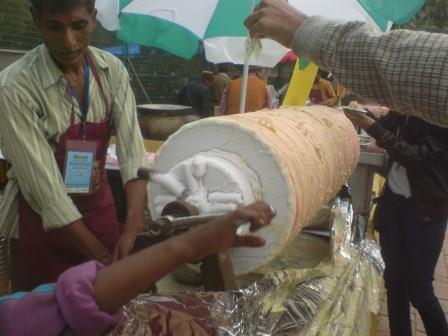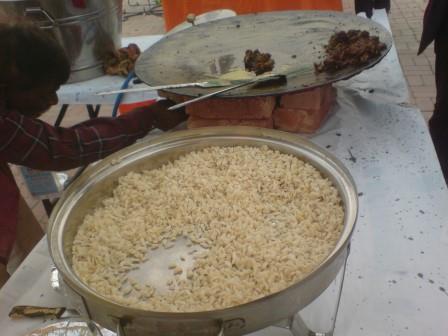As I was reading Robbar, the special supplement of Pratidin I recalled the picnic-calendar of my growing up years in Bengal. The arrival of winter and regret of its non-arrival would lie in the stapled packets of Band-Box or Shantipur Shawl Repairing House packets lying in the Godrej Almirah and the ultimate plan to organise picnics. The advent of winter would mark the task of writing essays on Charuibhati, Bonbhojon (Bengali words for picnic) in Bengali classes and to drawing competitions organised by local clubs on topics related to these. By December, calendar dates particularly Saturday and Sundays would be blocked for picnics. Like one of my roommates commented, a green patch, a strip of water is all that a Bengali family needs to set out for picnic. Geared with outdoor game sets of flying discs, badminton rackets and cricket bats, we set out for those picnics in matador vans, cars, buses, and trains depending on the nature of the organisation.
As children you tagged along with grumpy faces and the pressure of being well –behaved. In my case, my mother reminded me constantly not to take a second helping. Picnics in those days started with tiffin and ended with evening tea. Tiffin or breakfast on arrival would be slices of white bread sandwiched with a cube of butter, a boiled egg with shells on and a nice big singapori kala ( banana). Depending on the budget and the urgency to retain Bengali-ness there would be a nalen gur sandesh “date-palm jaggery sandesh” in the tiffin. Slices of cakes smelling of cherries ( this was pre- Monginis and Sugar & Spice Outlets – two brands that popularised confectionery items across Bengal) and oranges accompanied a cup of milky “nescafe” coffee mid-way between “tiffin” and “lunch”. Lunch would be Rice and Mutton Curry followed by tomato chutney. One had to dutifully put on the monkey-cap and sweaters while playing badminton for Bengalis are prone to catching cold even in temperatures which never hit beyond 15 Degree Celsius. Any outdoor activity in Winter (December – February) meant hand knit woollen gears. Such gears came in matching pairs and picnics were an occasion to dress up in those gears that our mothers, aunts dutifully wove the year before.
The torture and pleasure of being an adolescent and a little respectable came with staircases, lawns being given away to organise group picnics among your own age –group. This was the tasting time for all the observed skills of cooking you have acquired while being scolded for upsetting the order of cans and jars in kitchen. Menus of such picnics would be khichuri, chicken curry, rice and brinjal fritters ( beguni) .The group picnic site would be the terrace of a gentle kakima would come to the rescue when you have messed up or a gentle kaku who would negotiate on your behalf to the loud speakers that would blare out from the staircase. This was oposanskriti ( out of culture; literally).
Such defiance could increase if you became part of Tarun Sangha or Borun Sangha from your neighbourhood and took a matador ride with utsrinkhal chele ( indisciplined boys) for a picnic to a picnic spots. There are designated picnic spots across Bengal and to support what my roommate said, most of them are located against the backdrop of a waterbody. Such matadors would have two speakers in the front and back blaring out latest Bengali and Hindi Film Hits. While men and young boys were allowed to join such picnics, women were refrained taking part in such activities. Apart from the matador rides, remained family picnices by cars, hired buses or even train compartments.
One of my favourite picnics was an all girl’s picnic led by Pishimoni. Father’s Sister is called Pishi and Moni is an endearing way of addressing. To this date, I don’t know why we called her pishimoni except for the reason that my father called her didi ( sister) but she was my mother’s silaididimoni (craftsteacher). Pishimoni ran a shift crafts-school from our drawing room. On Thursdays, the sound of the singer machine would fill the air of the house and there were women across age –groups whom Pishimoni supervised with their needlework, knitting and craftwork. Except for the sound of the Singer Machine, there would be a pin-drop silence on Thursday afternoons. Pishimoni’s bag was a box of goodies as she would carry candies, nuts and other stuff from her regular train journeys to Kolkata, and other places. She took recourse to needle work and teaching women after her divorce. While our mothers were scared she adored us and we waited for the seasonal gifts that she brought us. Pishimoni used to organise a picnic and this was the best picnic. The kids (particularly I) had a say in the picnic menu and I loved the way she took take of the entire thing. Once my father wanted to join us as we were visiting this newly discovered “picnic spot” she said , Bhai ei ekta jayga to amader jonno chchere dao ( Brother, leave this space for us).
Though I did not understand what she meant, looking back, I cherish this all girls picnic. This picnic was Pishimoni’s way of teaching us to be independent of having our own tarun sangha and borun sangha with no matadors or blaring music but a space that my mothers, kakima called their own- a day to themselves.
©itiriti










